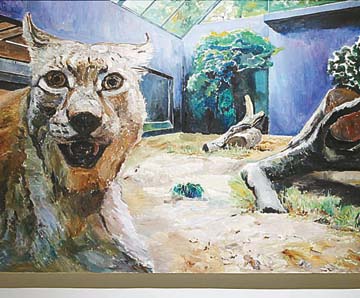|
Newman Huo
IN a steel cage, a chimpanzee in a white robe dies on the toilet with an open Bible, a copy of Charles Darwin’s book “On the Origin of Species,” and a pistol lying right in front of him.
This is what the young Chinese artist Qiu Anxiong has tried to present in his installation work, “The Doubter,” which is now being displayed in his one-man exhibition “Zoo” at the OCT Contemporary Art Terminal (OCAT) in Overseas Chinese Town, Nanshan District.
According to Qiu, the installation is a reconstruction of French painter Jacques-Louis David’s masterpiece, “The Death of Marat,” a painting from the French Revolution in the Age of Enlightenment observing the paradox that the goals of the revolution — freedom, democracy, and peace — became a tyrannical mania in which many people were beheaded.
“The chimpanzee in ‘The Doubter’ is the wise man of the animal kingdom, or even the one who enlightens, but in the eyes of humankind, the chimpanzee remains an animal,” Qiu said.
“Neither the Bible nor the theory of evolution grants animals treatment and rights equal to humankind, and the death of animals usually carries no meaning to speak of — whether they die naturally or are killed by a human hunter,” he said.

“The death of the chimpanzee on the toilet is undoubtedly dramatic, even monumental, but at the same time laughably absurd, as is its despair after reading the Bible and ‘On the Origin of Species,’” he said.
The exhibition, which will run until Aug. 23, features a series of oil paintings and installation works which Qiu has created in the past two years. The exhibition as a whole revolves around the scene of decaying zoological gardens.
Qiu’s oil paintings depict animals and their environments in zoos through a figurative technique — the most direct method of returning to the scenes of actual zoos and intervention into the personal perceptions and emotions of viewers.
Vultures, lynxes, bears, or tigers depicted within the cages and bars of these paintings are practically hospitalized in their artificial environments.
Giving off a feeling of decadence, the animals are lazy and indifferent and human viewers and animals remain separated.
Such paintings exist as a background to the exhibition, allowing the setting of the zoo to highlight the main theme of captivity.
Alongside this conceptual development, Qiu attempts to survey the broader meaning of captivity within more expansive spheres of culture, lifestyle and educational systems.
Qiu’s installation work, “Unspeakable Happiness,” appears to imitate the scene of a bland soap opera, which shows a cute family of rabbits watching television in a cozy and comfortable living room.
The rabbits look lethargic and happy, as if material satisfaction has made them drowsy. Everything looks completely normal, to the point that they have no way of realizing they are actually staying in a cage.
The installation “Anatomy,” which Qiu has most recently finished this year, uses industrial materials such as plastic tubes and circuit boards to produce a model similar to the internal organs of an animal.
Through his new work, Qiu said he intended to show that the materials produced by science, technology and social progress can ultimately only be lifeless, while the forms of life that have disappeared due to human progress will never be recreated.
Beginning with his widely known work “New Classic of the Mountains and Seas I,” Qiu has employed a method with which animals are metaphorically drawn into reality to develop his criticism on the contemporary society.
This unique narrative mode can be linked to the style of the Argentinian writer Jorge Luis Borges, but its spiritual quality is actually much closer to the critique of reality manifested in English novelist and journalist George Orwell’s novel, “Animal Farm.”
Born in Chengdu in 1972, Qiu exhibited in the Shanghai Biennale in 2006, China Power Station Part 1 in 2007, the Asia Pacific Triennial of Contemporary Art in 2009, and most recently the Sao Paulo Biennial in 2010.
He also held a solo exhibition at the Museum of Contemporary Art in Tokyo in 2007. His video work “New Classic of the Mountains and Seas II” and related print works have recently been acquired by the Museum of Modern Art in New York.
Dates: Through Aug. 23.
Hours: 10 a.m.-5:30 p.m. Closed Monday
Add: OCT Contemporary Art Terminal, Enping Road, Overseas Chinese Town (华侨城恩平路OCT当代艺术中心)
Buses: 21, 26, 32, 54, 59, 101, 105, 109, 121, 204, 209, 223, 234, 327, 328, 350, 370, 390
Metro: OCT Station (华侨城站), Exit A. Around five minutes’ walk along Enping Road
|

